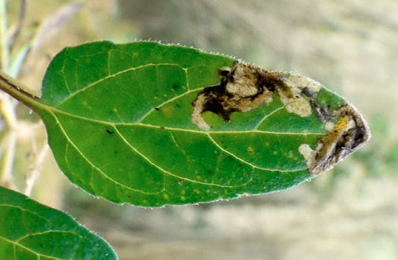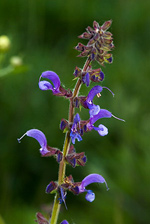|
||||||
|
SALVIA. Clarys. [Lamiaceae] |
|
|
Eighteen species and subspecies of Salvia are recorded in Britain.These include the native Meadow Clary (S. pratensis) and Wild Clary (S. verbenaca) and the introduced Annual Clary (S. viridis). Four British miners are recorded on Salvia. A key to the European miners recorded on Salvia is provided in Bladmineerders van Europa. |
|
|
Key for the identification of the known mines of British |
1a > Leaf-miner and case-bearer: Blotch mines reaching the edge of the leaf, initially pale green turning brownish white, are caused by the larva feeding on the underside of a leaf. The fully developed case is slender, shining black brown, about 9 mm long. Towards the end a narrow, transparent yellowish ventral keel. Mouth angle 50-60°. Cases on the leaf underside. |
|
Coleophora albitarsella Zeller, 1849 [Lepidoptera: Coleophoridae]. |
1b > Leaf-miner: A distinctive mine primarily above mid-rib, with irregular short lateral offshoots into leaf blade. Pupation external (Spencer, 1972: 51 (fig. 172), 55; Spencer, 1976: 270, 271 (fig. 486)). Branched, whitish, upper-surface corridor; main axis overlying the midrib; side branches overlying the main lateral veins. (In Campanula and Phyteuma the mine is much less branched, sometimes nothing more than a corridor on top of the midrib). Frass in rather long strings. Usually the mines begins as a long and narrow, shallow, tortuous lower-surface corridor that ends upon the midrib but otherwise is not associated with the leaf venation. Often this initial corridor is filled with callus, and then even less conspicuous. Pupation outside the mine. A linear mine on the upper surface, usually following the midrib and showing side branches along the veins. The frass is in strings. |
|
Liriomyza strigata (Meigen, 1830) [Diptera: Agromyzidae]. |
1c > Leaf-miner: Rather narrow corridor, untidy and sometimes branched, starting from the base of the leaf, in particular the midrib. Sides of the corridor irregularly eaten out, not really parallel. Frass mostly present, and then in a central line. The larva is capable of leaving the mine and start a new one elsewhere. These later mines are much broader, and the frass is scattered irregularly.. |
 Mine of Orthochaetes insignis on Prunella vulgaris Image: © Jean-Yves Baugnée (Bladmineerders van Europa) |
|
Orthochaetes insignis (Aube, 1863) [Coleoptera: Curculionidae] |
1d > Leaf-miner: Mine linear, whitish, both upper and lower surface. Pupation internal, at the end of the mine with the anterior spiracles projecting through the epidermis (Spencer, 1976: 433). Upper-surface, less often lower-surface corridor. Frass in isolated grains. Pupation within the mine, usually in a lower-surface puparial chamber. A long whitish upper surface corridor, which eventually goes lower surface. |
|
Chromatomyia horticola (Goureau, 1851) [Diptera: Agromyzidae]. |
1e > Leaf-mine: A winding corridor, upper- or lower surface, that regularly crosses itself, though without forming a secondary blotch. Secondary feeding lines absent. The mine is quite variable, sometimes a compact knot, sometimes a loose corridor along the leaf margin. Frass in discrete grains or pearl chains. The mine starts as a narrow gallery, which then often follows the leaf margin. It is just as often compressed into a small place. The mines may be upper or lower surface although these in York were found to be upper surface. The frass is in grains which may be close together and so looking like pearl strings. There are no primary or secondary feeding lines which distinguish it from Phytomyza salviae (British Leafminers). |
|
Phytomyza scotina Hendel, 1920 [Diptera: Agromyzidae] |
| Last updated 07-Jul-2019 Brian Pitkin | ||

